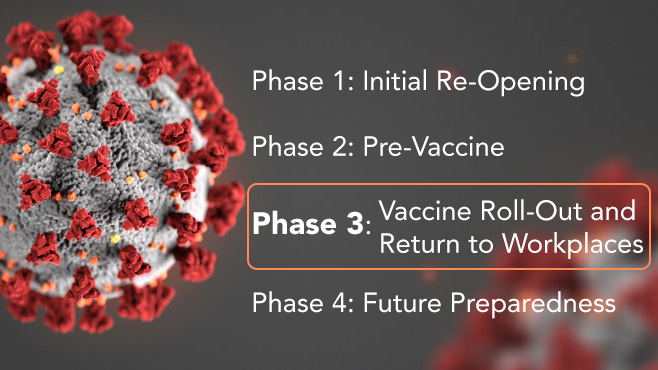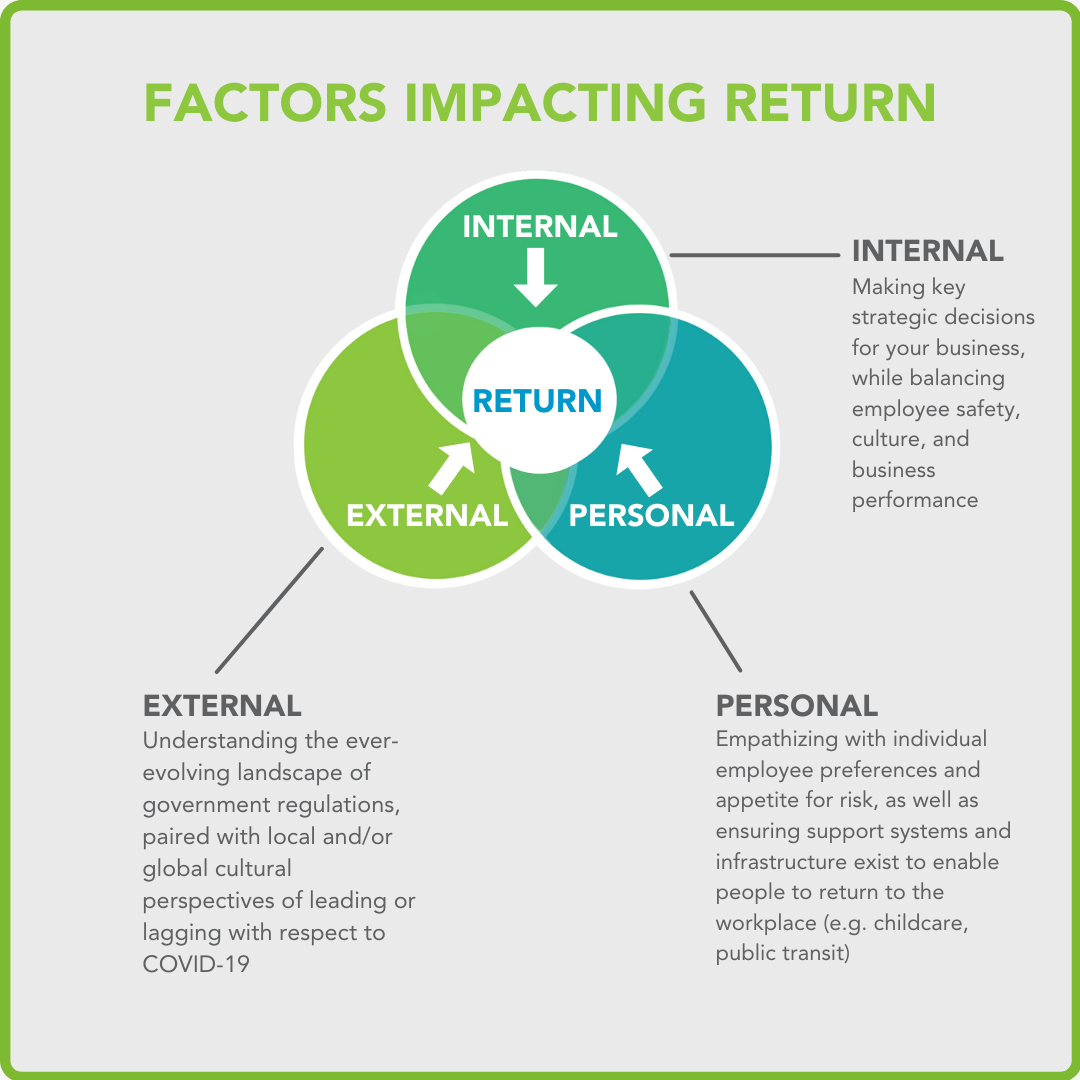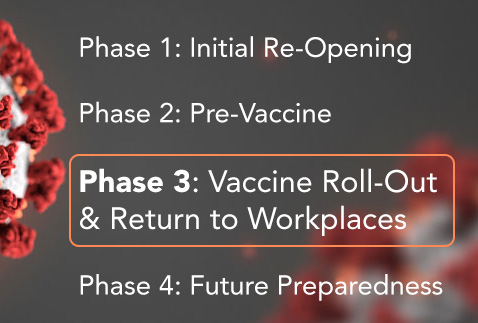COVID-19 business response – Phase 3: Vaccine roll-out and return to workplaces
 Mary Virzi / 8 April 2021
Mary Virzi / 8 April 2021The long-awaited distribution of COVID-19 vaccines has begun. This mass vaccination effort is expected to last several months, perhaps up to a couple of years, depending on several factors including geographic location, vaccine effectiveness against virus variants, and unfortunately, local economic wealth.
As herd immunity is in view for some countries, the time has come for business leaders to consider workplace re-opening plans. Some office buildings and other workplaces may never reopen, while others transform to accommodate a hybrid workforce (remote and in-person). Likewise, some employees may make the shift to permanent work at home, and most will now expect some sort of flexibility in their working arrangements1.
In Vynamic’s third COVID-19 Business Response Insight, we focus on what business leaders should consider in planning “return to workplace” now that vaccines are becoming more widely available.

(Read the first two Insights in our series on Initial Re-Opening and Leading During the Pre-Vaccination Phase.)
As referenced in our previous two Insights, we continue to see three key focus areas as people get back to the workplace:

Read on as we explore each of these areas in greater detail below.
Re-opening physical workplaces
We are well on our way to getting “back to normal.”
The CDC has released guidelines for what those who have been vaccinated can safely do2. For example, two vaccinated individuals can now safely be in a room together, with neither masks nor physical distancing. Likewise, a vaccinated individual can be indoors, with no masks and with no physical distancing, with an unvaccinated individual at low risk for severe COVID-19 disease. However, we are not out of the woods yet, and a number of countries in the EU (France3 and Germany4, among others) are experiencing fresh waves of the disease, even as vaccines are distributed and hope is on the horizon.
Opinions vary on when we will reach herd immunity in the United States or globally5. We are already seeing sports fans back in arenas and government restrictions are beginning to loosen, despite warnings from many experts in our medical and scientific communities not to forego safety precautions too soon.
The various opinions available on the “right” approach to re-opening can be overwhelming to navigate and apply directly to your business, so as you define your re-opening plan, we recommend taking a moment for introspection. Revisit your company’s core values, vision, and mission statement as you make these important decisions, and you can rest assured that you are making the right call.
External considerations
The status of the vaccine rollout, be it access to supply, local government readiness, or distribution infrastructure, varies widely across the globe. In some countries, like Israel, the United States, and the United Kingdom, there is adequate access to supply of at least one of several vaccines. And, while experiencing a few hiccups, the distribution infrastructure is largely working. However, there are some countries either struggling to secure a supply or grappling with infrastructure challenges (some regions of some countries are also doing better than others within the same country).
When considering reopening prior to achieving some form of herd immunity, we suggest considering the following:
- Vaccine access and adoption: What is the status of the vaccine rollout in your region, and what are near-term expectations for the rollout? Are people likely to want the vaccine when it is available? When does the scientific community predict your country or region will reach herd immunity?
- Government regulations: What, if any, government regulations are in place today? Balancing the vaccine rollout within new variants, easing restrictions, and a general population fed-up with lockdowns, what fluctuation in government regulations do you anticipate over the next 6-9 months?
- Brand equity: How do your decisions and actions reflect on your company in the public eye? How do you want your company to be perceived?
Internal considerations
As you examine your re-opening plan, review your organization’s strategic imperatives. What are you trying to achieve over the next 2-3 years, and how will the steps you take towards re-opening help or hinder those imperatives?
Also consider:
- Impact of the pandemic: What impact has the pandemic had on your business performance? Your culture? Your workforce? What are the key benefits to returning to in-person work for your company? What are the risks?
- Safety: What safety protocols and sanitary procedures have you/will you enact and enforce to keep your team safe as they come back to the office during this vaccination phase?
- Real estate footprint: What is your current real estate footprint? Do you anticipate needing that space in the future? Are significant real estate events approaching that you can take advantage of to make a change?
- Immediate term model: Will you transition to a hybrid remote/in-person model?
- Is this feasible for your business?
- Do you have the right technology infrastructure in place to enable a remote workforce? The right financial and accounting infrastructure (e.g., local tax)?
- What are the implications on culture and productivity?
- Future pandemic readiness: Do you have a pandemic playbook ready to swiftly enact necessary precautions/restrictions in the event of a COVID-19 surge, variant, or altogether new epidemic or pandemic?
Personal considerations
As this pandemic hopefully begins to draw to a close, each person’s willingness to return to an office building may depend on their own vaccination status and general access to vaccines in their local geography. We recommend leading with empathy and compassion for each employee’s unique experiences with COVID-19 and for their personal vaccination decision. As with all the questions posed thus far, now is a critical time to lean into your company’s values to identify the best return-to-workplace approach that considers both the personal safety (both physical and psychological) and preferences of your employees.
Additionally, leaders should consider the following in determining return-to-workplace plans:
- Define your vaccination point-of-view: Will you require your employees to be vaccinated before returning to the workplace? If so, how you can ensure your staff are receiving equitable treatment and distribution of the vaccine, while also balancing your country’s public health needs?
- Employee comfort-level: How can you help your employees balance their safety and comfort level with the “need” to be in the physical workplace to be effective? Alternatively, how can you continue to help employees to be effective remotely?
- Support services: When will infrastructure and support services come back online (e.g., childcare, schools returning to in-person instruction, public transportation, etc.)? Would you consider offering support services to those that need them?
- The future of work: What flexibility will you provide to your employees going forward? What, if any, policies will continue in the future?
Keeping your eyes on the horizon
With the end of the COVID-19 pandemic in sight for some countries, many are wondering what our “new normal” will look like. A couple of key themes have already emerged:
- Increased risk of pandemics: The scientific community warned several years ago that our increasing global interconnectedness, coupled with the uptick of infectious diseases could lead to more frequent, more severe, and more widespread pandemics. Drawing on lessons learned from the Spanish Flu of 1918, many in the scientific community believe that COVID-19 is here to stay6. Some will spread more easily and some could be deadlier, but hopefully most will be treatable to some degree by vaccines.
- Future of work: There is no doubt that this pandemic will have a tremendous impact on how we work. In many ways, it already has. As we look ahead, we see a few emerging topics around work starting to gain traction, including:
- The downsizing of corporate real estate
- The concept of work-leisure travel
- Specific to the healthcare industry, the future of relationships between patients and doctors (e.g., telehealth), as well as the relationship between life sciences and doctors (e.g., remote field force)
As the global vaccination campaign continues, business leaders will need to not only consider the external, internal, and personal factors we outlined here, but also keep their eye on the future, both near-term and long-term.
Stay tuned for our fourth and final Insight in our COVID-19 Response series, where we will dive into “Future Preparedness” later this year.
Need help? Contact us to explore if Vynamic can help your Return-to-Workplace initiatives or broader strategic planning to prepare your organization for a more resilient future.
Citations:
- Cutter, Chip. “Another Remote-Work Year Looms as Office-Reopening Plans Are Delayed”. The Wall Street Journal. 11 Feb 2021. 05 Apr 2021. https://www.wsj.com/articles/another-remote-work-year-looms-as-office-reopening-plans-are-delayed-11613039402?mod=article_inline
- “Guidance for Fully Vaccinated People”. Centers for Disease Control. 02 Apr 2021. 05 Apr 2021. https://www.forbes.com/sites/roberthart/2021/03/19/france-leads-fresh-wave-of-europe-lockdowns-as-nations-restart-astrazeneca-vaccine-rollout/?sh=5a7214b82aee
- Hart, Robert. “France Leads Fresh Wave of Europe Lockdowns as Nations Restart AstraZeneca Vaccine Rollout”. Forbes. 19 Mar 2021. 05 Apr 2021. https://www.forbes.com/sites/roberthart/2021/03/19/france-leads-fresh-wave-of-europe-lockdowns-as-nations-restart-astrazeneca-vaccine-rollout/?sh=5a7214b82aee
- “Germany warns of vaccines shortages as new COVID wave hits Europe”. Aljazeera. 19 Mar 2021. 05 Apr 2021. https://www.aljazeera.com/news/2021/3/19/germany-warns-of-vaccine-shortages-as-third-covid-wave-grips-eu
- Rodriguez, Carmen Heredia. “Can Vaccination and Infection Rates Add Up to Reach Covid Herd Immunity?”. KHN. 17 Mar 2021. 05 Apr 2021. https://khn.org/news/article/can-vaccination-and-infection-rates-add-up-to-reach-covid-herd-immunity/
- Scarpa, Raffaele. “May the analysis of 1918 influenza pandemic give hints to imagine the possible magnitude of Corona Virus Disease-2019 (COVID-19)?”. Journal of Translational Medicine. 22 Dec 2020. 05 Apr 2021. https://translational-medicine.biomedcentral.com/articles/10.1186/s12967-020-02673-6

About Vynamic
Vynamic, an Inizio Advisory company, is a leading management consulting partner to global health organizations across Life Sciences, Health Services, and Health Technology. Founded and headquartered in Philadelphia, Vynamic has offices in Boston, Durham NC, New York, and London. Our purpose is simple: We believe there is a better way. We are passionate about shaping the future of health, and for more than 20 years we’ve helped clients transform by connecting strategy to action.
Through a structured, yet flexible delivery model, our accomplished leaders work as an extension of client teams, enabling growth, performance, and culture. Vynamic has been recognized by organizations like Great Place to Work and Business Culture Awards for being leaders and innovators in consulting, company culture, and health. Visit Vynamic.com to discover how we can help transform your
organization or your career.
Want to learn more? Get in touch!
Other insights.
Jump to a slide with the slide dots.
 Prathima Guniganti
Prathima Guniganti
POV: Ensuring AI-Powered Omnichannel Strategies Deliver Expected Results
Learn how to optimize AI-powered omnichannel strategies for better engagement, data governance, and measurable results in life sciences
Read more Mindy McGrath
Mindy McGrath
The Case for Strategic Transformation: An Executive Conversation with Vynamic’s Leaders
Discover how healthcare orgs drive sustainable change through strategy, leadership, and execution—insights from Vynamic leaders.
Read moreU.S. Federal Health Agency Layoffs Pose Strategic Risk and Disruption to Life Sciences
Layoffs at U.S. health agencies, IRA, and budget cuts disrupt pharma—learn how life sciences can adapt and stay resilient.
Read more